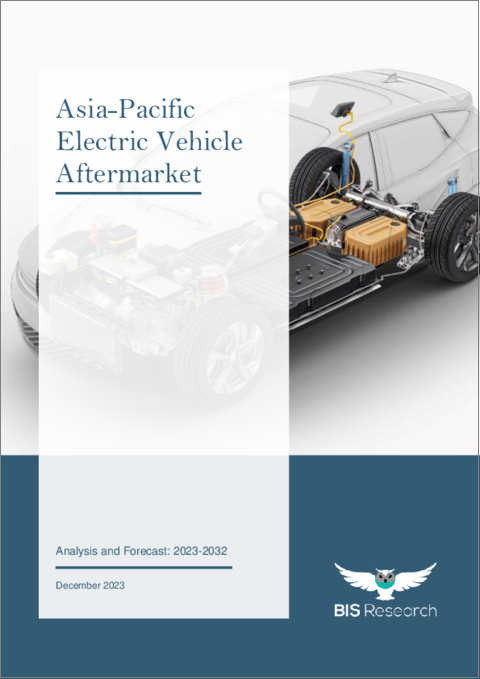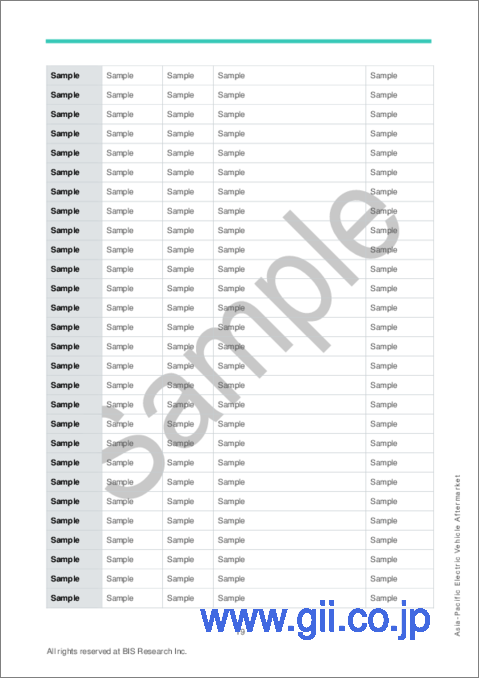|
|
市場調査レポート
商品コード
1393903
アジア太平洋の電気自動車アフターマーケット - 分析と予測(2023年~2032年)Asia-Pacific Electric Vehicle Aftermarket - Analysis and Forecast, 2023-2032 |
||||||
カスタマイズ可能
|
|||||||
| アジア太平洋の電気自動車アフターマーケット - 分析と予測(2023年~2032年) |
|
出版日: 2023年12月08日
発行: BIS Research
ページ情報: 英文 131 Pages
納期: 1~5営業日
|
- 全表示
- 概要
- 図表
- 目次
アジア太平洋の電気自動車アフターマーケット(中国を除く)の市場規模は、2022年の149億3,000万米ドルから2032年には762億3,000万米ドルに達すると予測され、予測期間の2023年~2032年のCAGRは17.95%になると見込まれています。
電気自動車のカスタマイズに対する顧客需要の高まり、電気自動車のセカンドライフアプリケーションの受け入れ拡大、電気自動車の人気の高まりが、電気自動車のアフターマーケットの拡大に拍車をかけると予測されます。
| 主要市場統計 | |
|---|---|
| 予測期間 | 2023年~2032年 |
| 2023年の評価額 | 172億5,000万米ドル |
| 2032年予測 | 762億3,000万米ドル |
| CAGR | 17.95% |
電気自動車の急速な普及、電気自動車のセカンドライフ用途への再利用傾向の拡大、電気自動車のパーソナライズに対する消費者の関心の高まりなど、多くの要因が電気自動車アフターマーケットを牽引しています。
研究開発(R&D)への多額の投資と電気自動車エコシステムの他の重要な参入企業との協力を通じて、電気自動車用アフターマーケットソリューションのサプライヤーとベンダーは、電気自動車用の最先端のアフターマーケットソリューションを提供しようと努力しています。電気自動車のアフターマーケットソリューションに対する需要は、電気自動車に対する需要の急速な高まり、政策、補助金、投資に対する行政機関の重視の高まり、脱炭素化に向けた自動車メーカーのシフトなど、多くの要因により、レビュー期間中に大幅に増加すると予想されます。
当レポートでは、アジア太平洋の電気自動車アフターマーケットについて調査し、市場の概要とともに、車両タイプ別、推進タイプ別、販売店舗別、販売方法別、部品別、地域別の動向、および市場に参入する企業のプロファイルなどを提供しています。
目次
第1章 市場
- 業界の見通し
- ビジネスダイナミクス
第2章 地域
- 中国
- アジア太平洋と日本
第3章 市場-競合ベンチマーキングと企業プロファイル
- 競合ベンチマーキング
- 主要市場プレーヤーのランキング
- 企業プロファイル
- NTN Corporation
- AISIN Corporation
- DENSO Corporation
- GUD Holdings Limited
- Bridgestone Corporation
- The Yokohama Rubber Co., Ltd.
- Akebono Brake Industry Co., Ltd.
- その他
第4章 調査手法
- データソース
- 市場の推定と予測
List of Figures
- Figure 1: Electric Vehicle Aftermarket (by Vehicle Type), $Billion, 2022-2032
- Figure 2: Electric Vehicle Aftermarket (by Propulsion Type), $Billion, 2022-2032
- Figure 3: Electric Vehicle Aftermarket (by Sales Outlet), $Billion, 2022-2032
- Figure 4: Electric Vehicle Aftermarket (by Mode of Sales), $Billion, 2022-2032
- Figure 5: Electric Vehicle Aftermarket (by Part), $Billion, 2022-2032
- Figure 6: Electric Vehicle Aftermarket (by Region), $Billion, 2022
- Figure 7: Electric Vehicle Aftermarket Structure
- Figure 8: Business Dynamics for Electric Vehicle Aftermarket
- Figure 9: Impact of Business Drivers
- Figure 10: EV Stock, Units, 2020-2022
- Figure 11: EV Sales Comparison (Cars), Units, 2020-2022
- Figure 12: Impact of Business Challenges
- Figure 13: Share of Key Business Strategies and Developments, 2021-2023
- Figure 14: Share of Key Product Developments, 2021-2023
- Figure 15: Share of Key Market Developments, 2021-2023
- Figure 16: Share of Key Corporate Strategies and Developments, 2021-2023
- Figure 17: Share of Key Partnerships, Collaborations, and Joint Ventures, 2021-2023
- Figure 18: Impact of Business Opportunities
- Figure 19: Competitive Benchmarking, 2022
- Figure 20: NTN Corporation: R&D Expenditure, $Million, 2020-2022
- Figure 21: AISIN Corporation: R&D Expenditure, $Billion, 2020-2022
- Figure 22: DENSO Corporation: R&D Expenditure, $Billion, 2020-2022
- Figure 23: GUD Holdings Limited: R&D Expenditure, $Million, 2020-2022
- Figure 24: Bridgestone Corporation: R&D Expenditure, $Million, 2020-2022
- Figure 25: The Yokohama Rubber Co., Ltd.: R&D Expenditure, $Million, 2020-2022
- Figure 26: Akebono Brake Industry Co., Ltd.: R&D Expenditure, $Million, 2020-2022
- Figure 27: Data Triangulation
- Figure 28: Top-Down and Bottom-Up Approach
List of Tables
- Table 1: Electric Vehicle Aftermarket Overview
- Table 2: Government Policies for Electric Vehicles, 2019-2023
- Table 3: List of Consortiums and Associations
- Table 4: Programs on Electric Vehicles by Research Institutions and Universities
- Table 5: Electric Vehicle Aftermarket (by Region), $Billion, 2022-2032
- Table 6: China Electric Vehicle Aftermarket (by Vehicle Type), $Billion, 2022-2032
- Table 7: China Electric Vehicle Aftermarket (by Propulsion Type), $Billion, 2022-2032
- Table 8: China Electric Vehicle Aftermarket (by Sales Outlet), $Billion, 2022-2032
- Table 9: China Electric Vehicle Aftermarket (by Mode of Sales), $Billion, 2022-2032
- Table 10: China Electric Vehicle Aftermarket (by Part), $Billion, 2022-2032
- Table 11: Asia-Pacific and Japan Electric Vehicle Aftermarket (by Vehicle Type), $Billion, 2022-2032
- Table 12: Asia-Pacific and Japan Electric Vehicle Aftermarket (by Propulsion Type), $Billion, 2022-2032
- Table 13: Asia-Pacific and Japan Electric Vehicle Aftermarket (by Sales Outlet), $Billion, 2022-2032
- Table 14: Asia-Pacific and Japan Electric Vehicle Aftermarket (by Mode of Sales), $Billion, 2022-2032
- Table 15: Asia-Pacific and Japan Electric Vehicle Aftermarket (by Part), $Billion, 2022-2032
- Table 16: Japan Electric Vehicle Aftermarket (by Vehicle Type), $Billion, 2022-2032
- Table 17: Japan Electric Vehicle Aftermarket (by Propulsion Type), $Billion, 2022-2032
- Table 18: Japan Electric Vehicle Aftermarket (by Sales Outlet), $Billion, 2022-2032
- Table 19: Japan Electric Vehicle Aftermarket (by Mode of Sales), $Billion, 2022-2032
- Table 20: Japan Electric Vehicle Aftermarket (by Part), $Billion, 2022-2032
- Table 21: South Korea Electric Vehicle Aftermarket (by Vehicle Type), $Million, 2022-2032
- Table 22: South Korea Electric Vehicle Aftermarket (by Propulsion Type), $Million, 2022-2032
- Table 23: South Korea Electric Vehicle Aftermarket (by Sales Outlet), $Million, 2022-2032
- Table 24: South Korea Electric Vehicle Aftermarket (by Mode of Sales), $Million, 2022-2032
- Table 25: South Korea Electric Vehicle Aftermarket (by Part), $Million, 2022-2032
- Table 26: Australia Electric Vehicle Aftermarket (by Vehicle Type), $Million, 2022-2032
- Table 27: Australia Electric Vehicle Aftermarket (by Propulsion Type), $Million, 2022-2032
- Table 28: Australia Electric Vehicle Aftermarket (by Sales Outlet), $Million, 2022-2032
- Table 29: Australia Electric Vehicle Aftermarket (by Mode of Sales), $Million, 2022-2032
- Table 30: Australia Electric Vehicle Aftermarket (by Part), $Million, 2022-2032
- Table 31: Rest-of-Asia-Pacific and Japan Electric Vehicle Aftermarket (by Vehicle Type), $Million, 2022-2032
- Table 32: Rest-of-Asia-Pacific and Japan Electric Vehicle Aftermarket (by Propulsion Type), $Million, 2022-2032
- Table 33: Rest-of-Asia-Pacific and Japan Electric Vehicle Aftermarket (by Sales Outlet), $Million, 2022-2032
- Table 34: Rest-of-Asia-Pacific and Japan Electric Vehicle Aftermarket (by Mode of Sales), $Million, 2022-2032
- Table 35: Rest-of-Asia-Pacific and Japan Electric Vehicle Aftermarket (by Part), $Million, 2022-2032
- Table 36: Key Market Player Ranking: Automotive Tires
- Table 37: Key Market Player Ranking: Automotive Brakes
- Table 38: Key Market Player Ranking: Electric Vehicle Batteries
- Table 39: Key Market Player Ranking: Automotive Wipers
- Table 40: Key Market Player Ranking: Automotive Lighting
- Table 41: NTN Corporation: Product Portfolio
- Table 42: NTN Corporation: Product Development
- Table 43: AISIN Corporation: Product Portfolio
- Table 44: DENSO Corporation: Product Portfolio
- Table 45: DENSO Corporation: Partnership, Collaboration, and Joint Venture
- Table 46: GUD Holdings Limited: Product Portfolio
- Table 47: Bridgestone Corporation: Product Portfolio
- Table 48: Bridgestone Corporation: Market Development
- Table 49: Bridgestone Corporation: Partnership, Collaboration, and Joint Venture
- Table 50: The Yokohama Rubber Co., Ltd.: Product Portfolio
- Table 51: The Yokohama Rubber Co., Ltd.: Product Development
- Table 52: The Yokohama Rubber Co., Ltd.: Market Development
- Table 53: The Yokohama Rubber Co., Ltd.: Partnership, Collaboration, and Joint Venture
- Table 54: Akebono Brake Industry Co., Ltd.: Product Portfolio
- Table 55: Akebono Brake Industry Co., Ltd.: Partnership, Collaboration, and Joint Venture
“The Asia-Pacific Electric Vehicle Aftermarket (excluding China) Expected to Reach $76.23 Billion by 2032.”
Introduction to Asia-Pacific Electric Vehicle Aftermarket
The Asia-Pacific electric vehicle aftermarket (excluding China) is projected to reach $76.23 billion by 2032 from $14.93 billion in 2022, growing at a CAGR of 17.95% during the forecast period 2023-2032. Rising customer demand for electric vehicle customization, growing acceptance of electric vehicle second-life applications, and growing popularity of electric vehicles are anticipated to fuel the expansion of the aftermarket for electric vehicles.
| KEY MARKET STATISTICS | |
|---|---|
| Forecast Period | 2023 - 2032 |
| 2023 Evaluation | $17.25 Billion |
| 2032 Forecast | $76.23 Billion |
| CAGR | 17.95% |
Market Introduction
A number of factors, including the rapid uptake of electric vehicles, the expanding trend of repurposing electric vehicles for second-life applications, and the growing consumer interest in personalizing electric vehicles, are driving the electric vehicle aftermarket.
Through large investments in research and development (R&D) and collaborations with other important players in the electric vehicle ecosystem, suppliers and vendors of aftermarket solutions for electric vehicles are striving to provide cutting-edge aftermarket solutions for electric vehicles. The demand for electric vehicle aftermarket solutions is expected to rise significantly during the review period due to a number of factors, including the rapidly rising demand for electric vehicles, the governing bodies' increasing emphasis on policies, subsidies, and investment, and the automakers' shifting focus towards decarbonization.
Market Segmentation:
Segmentation 1: by Vehicle Type
- Passenger Vehicles
- Commercial Vehicles
Segmentation 2: by Propulsion Type
- Battery Electric Vehicles (BEVs)
- Plug-In Hybrid Electric Vehicles (PHEVs)
- Hybrid Electric Vehicles (HEVs)
Segmentation 3: by Sales Outlet
- Authorized Service Centers
- Premium Multi-brand Service Centers
- Others
Segmentation 4: by Mode of Sales
- Offline sales
- Online sales
Segmentation 5: by Part
- Batteries
- Tires and Wheels
- Brakes and Suspensions
- Body Parts
- Others
Segmentation 6: by Region
- China
- Asia-Pacific and Japan
How can this report add value to an organization?
Product/Innovation Strategy: The product strategy helps the readers understand the different aftermarket solutions provided by the industry participants.
Growth/Marketing Strategy: The electric vehicle aftermarket is growing at a significant pace and holds enormous opportunities for market players. Some of the strategies covered in this segment are product launches, partnerships, collaborations, business expansions, and investments. The companies' preferred strategy has been product launches, partnerships, and collaborations to strengthen their positions in the global electric vehicle aftermarket.
Competitive Strategy: The key players in the Asia-Pacific electric vehicle aftermarket analyzed and profiled in the study include electric vehicle aftermarket solution providers that develop parts and accessories for EVs. Moreover, a detailed competitive benchmarking of the players operating in the electric vehicle aftermarket has been done to help the reader understand the ways in which players stack against each other, presenting a clear market landscape. Additionally, comprehensive competitive strategies such as partnerships, agreements, and collaborations are expected to aid the reader in understanding the untapped revenue pockets in the market.
Key Market Players and Competition Synopsis
The companies that are profiled have been selected based on inputs gathered from primary experts and analyzing company coverage, product portfolio, and regional presence.
Some of the prominent names in this market are:
|
|
Table of Contents
1 Markets
- 1.1 Industry Outlook
- 1.1.1 Trends: Current and Future
- 1.1.1.1 Electrification of Fleets
- 1.1.1.2 Governments Increase their Influence on the e-Mobility Industry
- 1.1.2 Electric Vehicle Aftermarket Structure
- 1.1.3 Ecosystem/Ongoing Programs
- 1.1.3.1 Consortiums, Associations, and Regulatory Bodies for Electric Vehicles
- 1.1.3.2 Programs on Electric Vehicles by Research Institutions and Universities
- 1.1.4 Automotive Aftermarket Dynamics
- 1.1.4.1 Declining Demand for Traditional Engines and Drivetrains
- 1.1.4.2 New Opportunities for Industry Players through Electric Vehicle Aftermarket across the Board
- 1.1.1 Trends: Current and Future
- 1.2 Business Dynamics
- 1.2.1 Business Drivers
- 1.2.1.1 Rising Popularity of Electric Vehicles
- 1.2.1.2 Proliferating Consumer Demand for Electric Vehicle Customization
- 1.2.1.3 Increasing Popularity of Electric Vehicle Second-Life Applications
- 1.2.2 Business Challenges
- 1.2.2.1 Lack of Electric Vehicle Aftermarket Infrastructure and Awareness
- 1.2.2.2 Cost and Availability Issues of Electric Vehicle Spare Parts
- 1.2.3 Business Strategies
- 1.2.3.1 Product Development
- 1.2.3.2 Market Development
- 1.2.4 Corporate Strategies
- 1.2.4.1 Mergers and Acquisitions
- 1.2.4.2 Partnerships, Collaborations, and Joint Ventures
- 1.2.5 Business Opportunities
- 1.2.5.1 Electric Vehicle Battery Repair and Replacement
- 1.2.5.2 EV Component Recycling and Disposal
- 1.2.5.3 Training and Education on Electric Vehicle Aftermarket
- 1.2.5.4 Shifting Trend toward E-commerce
- 1.2.1 Business Drivers
2 Regions
- 2.1 China
- 2.1.1 Market
- 2.1.1.1 Buyer Attributes
- 2.1.1.2 Key Solution Providers in China
- 2.1.1.3 Business Challenges
- 2.1.1.4 Business Drivers
- 2.1.2 Application
- 2.1.2.1 China Electric Vehicle Aftermarket (by Vehicle Type), Value Data
- 2.1.2.2 China Electric Vehicle Aftermarket (by Propulsion Type), Value Data
- 2.1.3 Product
- 2.1.3.1 China Electric Vehicle Aftermarket (by Sales Outlet), Value Data
- 2.1.3.2 China Electric Vehicle Aftermarket (by Mode of Sales), Value Data
- 2.1.3.3 China Electric Vehicle Aftermarket (by Part), Value Data
- 2.1.1 Market
- 2.2 Asia-Pacific and Japan
- 2.2.1 Market
- 2.2.1.1 Buyer Attributes
- 2.2.1.2 Key Solution Providers in Asia-Pacific and Japan
- 2.2.1.3 Business Challenges
- 2.2.1.4 Business Drivers
- 2.2.2 Application
- 2.2.2.1 Asia-Pacific and Japan Electric Vehicle Aftermarket (by Vehicle Type), Value Data
- 2.2.2.2 Asia-Pacific and Japan Electric Vehicle Aftermarket (by Propulsion Type), Value Data
- 2.2.3 Product
- 2.2.3.1 Asia-Pacific and Japan Electric Vehicle Aftermarket (by Sales Outlet), Value Data
- 2.2.3.2 Asia-Pacific and Japan Electric Vehicle Aftermarket (by Mode of Sales), Value Data
- 2.2.3.3 Asia-Pacific and Japan Electric Vehicle Aftermarket (by Part), Value Data
- 2.2.4 Asia-Pacific and Japan (by Country)
- 2.2.4.1 Japan
- 2.2.4.1.1 Market
- 2.2.4.1.1.1 Buyer Attributes
- 2.2.4.1.1.2 Key Solution Providers in Japan
- 2.2.4.1.1.3 Business Challenges
- 2.2.4.1.1.4 Business Drivers
- 2.2.4.1.2 Application
- 2.2.4.1.2.1 Japan Electric Vehicle Aftermarket (by Vehicle Type), Value Data
- 2.2.4.1.2.2 Japan Electric Vehicle Aftermarket (by Propulsion Type), Value Data
- 2.2.4.1.3 Product
- 2.2.4.1.3.1 Japan Electric Vehicle Aftermarket (by Sales Outlet), Value Data
- 2.2.4.1.3.2 Japan Electric Vehicle Aftermarket (by Mode of Sales), Value Data
- 2.2.4.1.3.3 Japan Electric Vehicle Aftermarket (by Part), Value Data
- 2.2.4.1.1 Market
- 2.2.4.2 South Korea
- 2.2.4.2.1 Market
- 2.2.4.2.1.1 Buyer Attributes
- 2.2.4.2.1.2 Key Solution Providers in South Korea
- 2.2.4.2.1.3 Business Challenges
- 2.2.4.2.1.4 Business Drivers
- 2.2.4.2.2 Application
- 2.2.4.2.2.1 South Korea Electric Vehicle Aftermarket (by Vehicle Type), Value Data
- 2.2.4.2.2.2 South Korea Electric Vehicle Aftermarket (by Propulsion Type), Value Data
- 2.2.4.2.3 Product
- 2.2.4.2.3.1 South Korea Electric Vehicle Aftermarket (by Sales Outlet), Value Data
- 2.2.4.2.3.2 South Korea Electric Vehicle Aftermarket (by Mode of Sales), Value Data
- 2.2.4.2.3.3 South Korea Electric Vehicle Aftermarket (by Part), Value Data
- 2.2.4.2.1 Market
- 2.2.4.3 Australia
- 2.2.4.3.1 Market
- 2.2.4.3.1.1 Buyer Attributes
- 2.2.4.3.1.2 Key Solution Providers in Australia
- 2.2.4.3.1.3 Business Challenges
- 2.2.4.3.1.4 Business Drivers
- 2.2.4.3.2 Application
- 2.2.4.3.2.1 Australia Electric Vehicle Aftermarket (by Vehicle Type), Value Data
- 2.2.4.3.2.2 Australia Electric Vehicle Aftermarket (by Propulsion Type), Value Data
- 2.2.4.3.3 Product
- 2.2.4.3.3.1 Australia Electric Vehicle Aftermarket (by Sales Outlet), Value Data
- 2.2.4.3.3.2 Australia Electric Vehicle Aftermarket (by Mode of Sales), Value Data
- 2.2.4.3.3.3 Australia Electric Vehicle Aftermarket (by Part), Value Data
- 2.2.4.3.1 Market
- 2.2.4.4 Rest-of-Asia-Pacific and Japan
- 2.2.4.4.1 Market
- 2.2.4.4.1.1 Buyer Attributes
- 2.2.4.4.1.2 Key Solution Providers in Rest-of-Asia-Pacific and Japan
- 2.2.4.4.1.3 Business Challenges
- 2.2.4.4.1.4 Business Drivers
- 2.2.4.4.2 Application
- 2.2.4.4.2.1 Rest-of-Asia-Pacific and Japan Electric Vehicle Aftermarket (by Vehicle Type), Value Data
- 2.2.4.4.2.2 Rest-of-Asia-Pacific and Japan Electric Vehicle Aftermarket (by Propulsion Type), Value Data
- 2.2.4.4.3 Product
- 2.2.4.4.3.1 Rest-of-Asia-Pacific and Japan Electric Vehicle Aftermarket (by Sales Outlet), Value Data
- 2.2.4.4.3.2 Rest-of-Asia-Pacific and Japan Electric Vehicle Aftermarket (by Mode of Sales), Value Data
- 2.2.4.4.3.3 Rest-of-Asia-Pacific and Japan Electric Vehicle Aftermarket (by Part), Value Data
- 2.2.4.4.1 Market
- 2.2.4.1 Japan
- 2.2.1 Market
3 Markets - Competitive Benchmarking & Company Profiles
- 3.1 Competitive Benchmarking
- 3.1.1 Key Market Player Ranking
- 3.1.1.1 Key Market Player Ranking: Automotive Tires
- 3.1.1.2 Key Market Player Ranking: Automotive Brakes
- 3.1.1.3 Key Market Player Ranking: Electric Vehicle Batteries
- 3.1.1.4 Key Market Player Ranking: Automotive Wipers
- 3.1.1.5 Key Market Player Ranking: Automotive Lighting
- 3.1.1 Key Market Player Ranking
- 3.2 Company Profiles
- 3.2.1 NTN Corporation
- 3.2.1.1 Company Overview
- 3.2.1.1.1 Role of NTN Corporation in Electric Vehicle Aftermarket
- 3.2.1.1.2 Product Portfolio
- 3.2.1.1.3 Company Offices
- 3.2.1.1.4 R&D Analysis
- 3.2.1.2 Business Strategies
- 3.2.1.2.1 Product Development
- 3.2.1.3 Analyst View
- 3.2.1.1 Company Overview
- 3.2.2 AISIN Corporation
- 3.2.2.1 Company Overview
- 3.2.2.1.1 Role of AISIN Corporation in the Electric Vehicle Aftermarket
- 3.2.2.1.2 Product Portfolio
- 3.2.2.1.3 R&D Analysis
- 3.2.2.1.4 Company Offices
- 3.2.2.2 Analyst View
- 3.2.2.1 Company Overview
- 3.2.3 DENSO Corporation
- 3.2.3.1 Company Overview
- 3.2.3.1.1 Role of DENSO Corporation in the Electric Vehicle Aftermarket
- 3.2.3.1.2 Product Portfolio
- 3.2.3.1.3 R&D Analysis
- 3.2.3.1.4 Company Offices
- 3.2.3.2 Corporate Strategies
- 3.2.3.2.1 Partnership, Collaboration, and Joint Venture
- 3.2.3.3 Analyst View
- 3.2.3.1 Company Overview
- 3.2.4 GUD Holdings Limited
- 3.2.4.1 Company Overview
- 3.2.4.1.1 Role of GUD Holdings Limited in the Electric Vehicle Aftermarket
- 3.2.4.1.2 Product Portfolio
- 3.2.4.1.3 R&D Analysis
- 3.2.4.1.4 Company Offices
- 3.2.4.2 Analyst View
- 3.2.4.1 Company Overview
- 3.2.5 Bridgestone Corporation
- 3.2.5.1 Company Overview
- 3.2.5.1.1 Role of Bridgestone Corporation in the Electric Vehicle Aftermarket
- 3.2.5.1.2 Product Portfolio
- 3.2.5.1.3 R&D Analysis
- 3.2.5.1.4 Company Offices
- 3.2.5.2 Business Strategies
- 3.2.5.2.1 Market Development
- 3.2.5.3 Corporate Strategies
- 3.2.5.3.1 Partnership, Collaboration, and Joint Venture
- 3.2.5.4 Analyst View
- 3.2.5.1 Company Overview
- 3.2.6 The Yokohama Rubber Co., Ltd.
- 3.2.6.1 Company Overview
- 3.2.6.1.1 Role of The Yokohama Rubber Co., Ltd. in the Electric Vehicle Aftermarket
- 3.2.6.1.2 Product Portfolio
- 3.2.6.1.3 R&D Analysis
- 3.2.6.1.4 Company Offices
- 3.2.6.2 Business Strategies
- 3.2.6.2.1 Product Development
- 3.2.6.2.2 Market Development
- 3.2.6.3 Corporate Strategies
- 3.2.6.3.1 Partnership, Collaboration, and Joint Venture
- 3.2.6.4 Analyst View
- 3.2.6.1 Company Overview
- 3.2.7 Akebono Brake Industry Co., Ltd.
- 3.2.7.1 Company Overview
- 3.2.7.1.1 Role of Akebono Brake Industry Co., Ltd. in the Electric Vehicle Aftermarket
- 3.2.7.1.2 Product Portfolio
- 3.2.7.1.3 R&D Analysis
- 3.2.7.1.4 Company Offices
- 3.2.7.2 Corporate Strategies
- 3.2.7.2.1 Partnership, Collaboration, and Joint Venture
- 3.2.7.3 Analyst View
- 3.2.7.1 Company Overview
- 3.2.1 NTN Corporation
- 3.3 Other Companies
4 Research Methodology
- 4.1 Data Sources
- 4.1.1 Primary Data Sources
- 4.1.2 Secondary Data Sources
- 4.1.3 Data Triangulation
- 4.2 Market Estimation and Forecast
- 4.2.1 Factors for Data Prediction and Modeling






